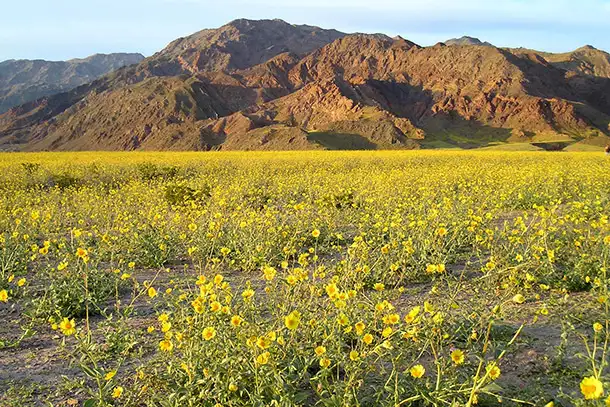
It’s time to celebrate! This year marks the 100th anniversary of the National Parks Service, and we’re honoring the centennial by featuring one great park perfect for every month. As a bonus, we’ll also give you the scoop on a less-known park that’s perfectly in-season.
Why Death Valley National Park Is Amazing
Death Valley is the largest national park outside of Alaska and, at 282 feet below sea level, includes the lowest point on the continent. It’s also a world unto itself.
The park’s geography is as foreboding as it is mesmerizing. Sand dunes roll for miles as naked mountains tower in the distance. Sedimentary badlands, volcanic craters, and cinder cones appear seemingly out of nowhere. “Sailing rocks” move, inexplicably, across a dry lakebed. Many of the park’s features bear morbid monikers—Coffin Peak, Badwater, Furnace Creek— but the names belie an ecosystem that has adapted and managed to thrive in this hostile environment. Big-horn sheep, coyote, kangaroo rats, endangered desert tortoises, and roadrunners are just a few of the hundreds of mammal, reptile, and bird species found here. There are also more than 1,000 plant species, 21 of which are found only in Death Valley.
The Furnace Creek Visitor Center and nearby Ranch at Furnace Creek work closely together, forming the hub for activities at the park. (Scotty’s Castle, the park’s other visitor center, was damaged by flooding in October 2015 and isn’t scheduled to re-open until late 2016.) The visitor center can direct you to some of the park’s most popular attractions, including Artist’s Drive, the Racetrack, Dante’s View, and Ubehebe Crater.
In addition to accommodations at the Ranch at Furnace Creek, other options include the Inn at Furnace Creek, Panamint Springs Resort and Stovepipe Wells Village. Or, you can disappear into the desert for some backcountry camping, but note: Four-wheel drive is absolutely required.
RELATED: The Best National Parks for Each Season
Why February Is the Perfect Time to Go
The high season in Death Valley is roughly November through late March/early April, while desert temperatures are mild and comfortable. And this year, courtesy of warm El Niño rains that began in November, the desert is already alive with wildflowers in what promises to be a spectacular season. Verbena, brown-eyed evening primrose, and desert gold are already blooming. Flowering species and locations will shift, gradually moving up in elevation, but you can zero in on the best viewing spots by following the wildflower updates posted on the park’s website and also on Facebook. There’s a chance you could encounter a shower or two in February, but this is good news for wildflower fans, because a little more rain this spring will ensure what botanists call a “super-bloom,” a year of exceptionally dense and dramatic wildflowers, which happens only every 10 years or so.
Why It’s Great at Other Time of Year
Summer brings fiendish, unforgiving heat to the park, with summer temperatures that can top 120 degrees. In fact, Death Valley is generally recognized as having the highest temperature ever recorded on Earth: 134 degrees on July 10, 1913. And yet … curiously enough, July and August have become two of the most popular months in the park, due to “heat tourism,” mostly foreign visitors who come to the park to experience the blast furnace that is Death Valley in summertime. Don’t even think of attempting this without a hat, sunglasses, clothing to block the sun and wind, and as much drinking water as you can carry.
RELATED: January’s National Park of the Month: Everglades
If You Go, Don’t Miss
In 2013, Death Valley became the world’s largest International Dark Sky Park, providing stargazers clear, unobstructed views of the stars and constellations thanks to its remote location. From November through April, the park offers evening programs Friday through Sunday that often include stargazing activities (they’re posted on the weekly calendar). And each month, rangers set up telescopes on the new moon, when the lack of lunar light makes for optimum star-viewing conditions. In February, the park joins Furnace Creek Lodge in hosting the Death Valley Winter Star Party, in association with the Las Vegas Astronomical Society.
February Bonus Pick: Acadia National Park
Despite being one of the top-10 most visited national parks in the country, this time of year is a perfect choice for those seeking a quiet, snowy winter retreat in Maine’s Acadia National Park. With little automobile traffic (most of the Park Loop Road scenic drive is closed), winter-sports enthusiasts can enjoy cross-country skiing, snowshoeing, hiking, and even camping in the back country. And this year, from Feb. 26 through March 6, the park celebrates its centennial with the Acadia Winter Festival, which will include winter photography workshops, ice-carving demos, dog sledding, ice-carving demos, an ice-golf tournament, and more.
More from SmarterTravel:
- 10 Secret Mexican Islands You Can Have All to Yourself
- 7 Wild National Park Adventures You’ll Never Forget
- 10 National Parks You Never Knew Existed
Deb Hopewell is a longtime journalist and the former editor of Yahoo Travel. She writes for Outside, Fodor’s, Architectural Digest, Travel+Leisure, Yahoo Travel, and others. Follow her on Instagram @debhopewell and Twitter @dhopewell.
(Photo: National Parks Service)
We hand-pick everything we recommend and select items through testing and reviews. Some products are sent to us free of charge with no incentive to offer a favorable review. We offer our unbiased opinions and do not accept compensation to review products. All items are in stock and prices are accurate at the time of publication. If you buy something through our links, we may earn a commission.
Related
Top Fares From
Today's Top Travel Deals
Brought to you by ShermansTravel
France: 8-Night Paris, Avignon & Nice...
Infinity Worldwide Vacations
 vacation
$2880+
vacation
$2880+
Poconos: 3 Nts in Garden of...
ResortsAndLodges.com
 hotel
$305+
hotel
$305+
7-Nt Canada & New England Cruise,...
Princess Cruises
 cruise
$839+
cruise
$839+



